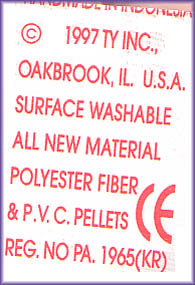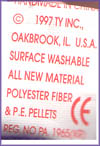In the whimsical world of Beanie Babies, every detail matters – from the intricately designed tags to the plush fabric and, yes, even the tiny pellets nestled within. For collectors, understanding the nuances of these pellets can mean the difference between a standard find and a prized gem.
In this article, we delve into the debate surrounding PVC vs PE pellets and explore whether these material choices have any impact on Beanie Baby prices. So grab your magnifying glass and join us on a journey through the fascinating world of collectible critters!
This section delves into the amazing world of the small plastic pellets nestled inside Beanie Babies. In 1998, Ty made a significant environmental move by swapping out PVC pellets for PE pellets, deemed more eco-friendly. This change not only reflects a shift towards sustainability but also adds an intriguing dimension to the collectible landscape. Beanie Babies containing PVC pellets are often prized for their rarity and can command higher values, particularly the elusive Princess with PVC pellets.
This means that every Beanie Baby with a Gen 1-4 hang tag will contain PVC Pellets. (Except for Princess, which has a unique tag resembling Gen 4 but is classified as Gen 5.) Similarly, Beanies with a Gen 6 or later tag will consistently feature PE Pellets, as will the majority of Gen 5.
The transition to Gen 5 hang tags began around late 1997 (November or December), coinciding with the switch to PE pellets around January of 1998. This shift is discernible because newly announced releases on 12/31/97 are all found with PVC Pellets, while Erin, introduced a month later, cannot be found with PVC. Interestingly, the prevalence of PVC pellets is frequently mentioned in eBay listings, suggesting that if a PVC Erin existed, it would have been highlighted. Given this timeline, approximately 80 Beanies with a combination of Gen 5 hang tags (and Gen 6 tush) with PVC Pellets exist, with a few being PVC exclusive.
These Beanies are the only ones where pellet type could be considered a point of interest, as it’s otherwise standard for other releases. However, the reality is that very few collectors would consider this feature worth paying extra for. It’s an intriguing detail for those with extensive knowledge of Beanies but typically doesn’t significantly impact prices, if at all. Princess, once again, stands as one of the few exceptions that still hold collectible / resale value today.
How can you discern which pellets reside within your cherished Beanie Babies? Well, it’s all in the tush tags!


P.E. stands for polyethylene, while P.V.C. stands for polyvinylchloride. But what sets these pellets apart in terms of texture? PE pellets feel like half-spheres, whereas PVC pellets are smaller and cylindrical, with one side rounded.
In a groundbreaking move towards environmental responsibility, TY, the maker of Beanie Babies, transitioned to polyethylene pellets following discussions with Greenpeace USA. This decision marks a historic milestone, reducing toxicity in toys and eliminating a significant source of deadly dioxin from PVC manufacturing and disposal processes.
Why the fuss about dioxin? Well, it’s one of the nastiest, most toxic chemicals around, second only to radioactive waste. Formed as a by-product of manufacturing, molding, or burning organic chemicals and plastics containing chlorine, dioxin poses severe health risks. Its association with infamous environmental disasters like Love Canal and Times Beach underscores the urgency of TY’s eco-conscious shift away from PVC pellets.
Which Are Worth More – PVC Beanie Babies or PE Beanie Babies?
In general, Beanie Babies with PVC pellets are often perceived as more rare and therefore may command higher prices in the collector’s market. This is particularly true for certain sought-after editions like Princess with PVC pellets. However, the difference in value between PVC and PE Beanie Babies can vary depending on individual collector preferences and market trends.
Princess PVC vs Princess PE – Which Variation Is Worth More?
Princess made her grand entrance into the Beanie Baby world on October 29, 1997, announced as a special edition bear to honor Princess Diana and support the Diana of Wales Memorial Fund. However, like many releases, she didn’t hit store shelves right away – reports of her first shipments in the US surfaced around mid-December. Initially, stores were only allocated 12 bears each, leading to a frenzy among collectors who feared this might be the only chance to snag one.
This anticipation fueled speculation of Princess becoming one of the rarest and most valuable Beanies ever. Yet, the excitement was short-lived when it became clear that more batches were on the horizon. Princess continued production until April 1999 and is now considered quite common.
Despite this, the aura of rarity still surrounds Princess, fueled in part by inflated prices paid during the initial hype. Some sellers exploit this misconception, inflating its value with exaggerated stories, and unfortunately, buyers sometimes fall for it. Media attention further perpetuated the myth, leading to Princess frequently topping lists of rarest Beanies. However, a closer look reveals that most sell for under $10 on eBay, if one bothers to dig deep enough past misleading listings.
Nevertheless, Princess’s minor variations have been scrutinized intensely, with some collectors seeing them as potential gold mines. Unfortunately, they are very, very common. The rarity of Princess is influenced by factors like pellet type (PVC being rarer), manufacturing location (Indonesia being rarer), the presence of a second Canadian tush tag (rarer), and even details like line breaks in the hang tag’s charity info. Some of the more rare combinations of PVC + Indonesia + Canadian Tush could reach $100+ today.
